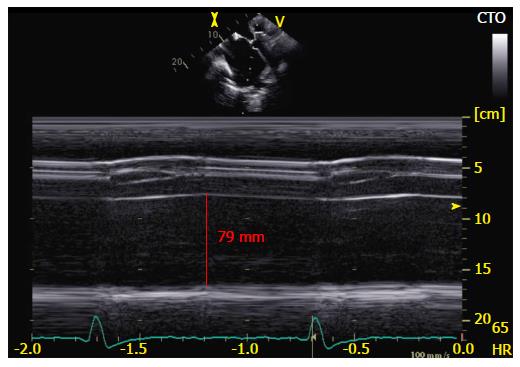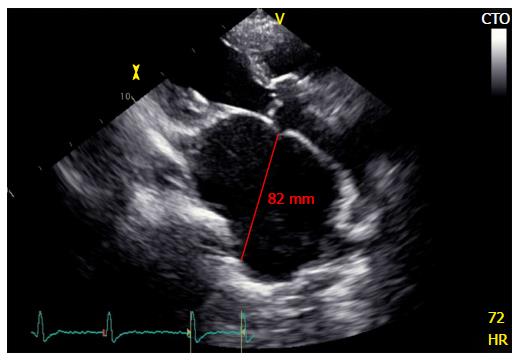Published online Jun 26, 2016. doi: 10.4330/wjc.v8.i6.375
Peer-review started: February 1, 2016
First decision: March 1, 2016
Revised: April 1, 2016
Accepted: April 14, 2016
Article in press: April 18, 2016
Published online: June 26, 2016
A 78-year-old asymptomatic woman was referred to our clinic for a second opinion regarding indication for mitral valve surgery. An echocardiogram showed a moderate mitral stenosis with a concomitant severe regurgitation. The most striking feature, however, was a giant left atrium with a parasternal anteroposterior diameter of 79 mm and a left atrial volume index of 364 mL/m². There are various echocardiographic definitions of a giant left atrium, which are mainly based on measurements of the anteroposterior diameter of the left atrium using M-mode in the parasternal long axis view. Since the commonly accepted method for echocardiographic evaluation of left atrial size is left atrial volume index, we propose a cut-off value of 140 mL/m2 for the definition of a “giant left atrium”.
Core tip: There are various echocardiographic definitions of a giant left atrium, which are mainly based on measurements of the anteroposterior diameter of the left atrium using M-mode in the parasternal long axis view. Since the commonly accepted method for echocardiographic evaluation of left atrial size is left atrial volume index, we propose a cut-off value of 140 mL/m2 for the definition of a “giant left atrium”.
- Citation: Özkartal T, Tanner FC, Niemann M. Asymptomatic post-rheumatic giant left atrium. World J Cardiol 2016; 8(6): 375-378
- URL: https://www.wjgnet.com/1949-8462/full/v8/i6/375.htm
- DOI: https://dx.doi.org/10.4330/wjc.v8.i6.375
Early in the 20th century Owen and Fenton[1] presented “A case of extreme dilatation of the left auricle of the heart”. The patient initially presented because of dyspnea, which after clinical examination was thought to be due to a right sided pleural effusion. However, paracentesis produced pure blood. Postmortem examination showed a severely enlarged left atrium occupying the entire thoracic cavity that was accidentally punctured during paracentesis. To our knowledge, this is the first published case of a so called “giant left atrium”, a term that was introduced by Fisher et al[2] in 1956.
It is well known that various cardiac conditions such as valvular heart disease, systolic or diastolic dysfunction of the left ventricle, atrial fibrillation and others can cause an enlargement of the left atrium. However, an enlargement fulfilling the criteria for “giant left atrium” is most commonly due to mitral valve pathology, in particular mitral valve stenosis[3].
A 78-year-old woman with known atrial fibrillation and arterial hypertension was referred to our clinic for a second opinion regarding indication for mitral valve surgery. As a child she had suffered from rheumatic fever and subsequently developed mitral valve dysfunction. However, having been asymptomatic ever since, she refused surgery in the past - even when an endocarditis of the mitral valve with enterococcus coli in 2013 was detected. The endocarditis was treated conservatively at that time.
At presentation the patient denied any cardiac symptoms such as dyspnea, nocturia, chest pain or palpitations. She was able to walk two floors without a break and was perfectly capable of mastering her daily life.
Physical examination showed an alert and oriented patient. The pulse was irregular with 53 beats per minute, respiration rate was normal and systolic blood pressure was elevated with 167/83 mmHg. A 2/6 holosystolic heart murmur was present at the left sternal border and at the apex with radiation to the left axilla. The lungs were clear to auscultation with no crackles or wheezes. No signs of volume retention such as distension of the jugular veins, peripheral edema or positive hepatojugular reflux were present.
The electrocardiogram showed atrial fibrillation with a heart rate of 56 beats per minute and a left anterior fascicular block. Apart from a slightly reduced kidney function with an estimated glomerular filtration rate of 61 mL/min (CKD-EPI 2009) and an elevated proBNP of 1345 ng/L (normal < 738 ng/L) there were no pathologic findings.
On the treadmill exercise test the patient reached 5.2 metabolic equivalent of task without cardiac symptoms or significant ECG changes. The test had to be abandoned due to joint pain in the knees.
An echocardiogram showed a moderately dilated left ventricle (end-diastolic volume index: 88 mL/m2) with a moderately reduced ejection fraction of 38% due to global hypokinesis. The mitral annulus was calcified. In a pattern consistent with post-rheumatic changes the mitral valve leaflets were thickened and partially calcified. Moderate mitral stenosis with a mean diastolic pressure of 7 mmHg and a concomitant severe regurgitation was present. The estimated pulmonary pressure was slightly elevated (41 mmHg), the dimension and function of the right ventricle normal. The most striking feature, however, was a giant left atrium with an anteroposterior diameter of 79 mm (Figure 1), a left atrial circumference of 88 cm2, a total volume of 525 mL and a left atrial volume index (LAVI) of 364 mL/m² (see audio core tip).
Left atrial size is influenced by increased left atrial pressure and its duration. Hence, left atrial dilatation occurs under various cardiac conditions such as mitral valve disease, left ventricular systolic as well as diastolic dysfunction and others. In general it can be assumed that the more severe and chronic the cardiac condition, the larger the left atrium. The chronicity might be a key factor why the patient presented such a dilated atrium, having suffered from rheumatic fever as a child and subsequently developed mitral stenosis (and regurgitation). The persistent atrial fibrillation as well as arterial hypertension certainly contributed to the severity of left atrial enlargement.
There are several empirical definitions of giant left atrium, but no established diagnostic criteria[4] so far. Piccoli et al[5] published a paper in 1984 using a cardiothoracic ratio > 0.7 on chest X-ray in combination with an echocardiographic and angiographic evidence of aneurysmal dilatation of the left atrium to define giant left atrium. The measured atrial anteroposterior diameters ranged from 7 to 12 cm. Isomura et al[6] defined a left atrium as giant, if the echocardiographic diameter exceeded 6.0 cm. In 1991 Minagoe et al[7] used another arbitrary anteroposterior diameter of 65 mm in the parasternal long axis view using M-mode echocardiography as a cut-off value (Figure 1). To our knowledge this is the generally used echocardiographic criteria for a giant left atrium. All echocardiographic cut-off values have in common that they are based on a single, monoplane, linear measurement.
In clinical practice, however, we occasionally are confronted with severely enlarged and anatomically distorted left atria, making it difficult to find a correct angle for an adequate measurement of the anteroposterior diameter in M-mode. This can even lead to different values between measurements in M- and B-mode (Figures 1 and 2). Moreover, since the left atrium is a three dimensional structure, we think that the LAVI is a more suitable method for evaluating its size.
Interestingly, no definition of a giant left atrium based on indexed left atrial volume is available. An anteroposterior atrial diameter below 40 mm is regarded normal, a value above 65 mm “giant”, corresponding to 1.6 times the normal value. A LAVI below 34 mL/m2 is regarded as normal[8]. Thus, LAVI being a three dimensional measurement, one might extrapolate a LAVI of more than 140 mL/m2 as a cut off for a giant left atrium (> 1.6 times of the length in each of the three spatial directions: 34 mL/m²× 1.6³). However, this cut off is arbitrary and the prognostic relevance, whether an atrium is severely dilated or “giant left atrium”, is unknown. This has to be explored in future studies.
A 78-year-old patient with rheumatic heart disease and no cardiac symptoms such as dyspnea, nocturia, chest pain or palpitations.
Irregular heart beat with a rate of 53 beats per minute, elevated blood pressure with 167/83 mmHg and a 2/6 holosystolic heart murmur at the left sternal border and the apex with radiation to the left axilla.
Severely enlarged left atrium because of mitral valve pathology due to rheumatic heart disease, persistent atrial fibrillation and arterial hypertension.
Reduced estimated glomerular filtration rate of 61 mL/min as a sign of chronic kidney disease stage 2 and increased proBNP of 1345 ng/L as a marker for chronic heart failure.
Echocardiography showed a giant left atrium with a left atrial total volume of 525 mL and an indexed volume of 364 mL/m².
Medication for chronic heart failure, i.e., ACE-inhibitor, beta-blocker and loop diuretic and a vitamin K antagonist for atrial fibrillation.
Rheumatic heart disease is defined by the world heart federation as a chronic heart condition caused by rheumatic fever due to a preceding group A streptococcal infection that can cause fibrosis of heart valves, leading to crippling valvular heart disease, heart failure and death.
M-mode is an echocardiographic modality (M for motion) with high temporal resolution of up to 1000 Hz that allows detailed analysis of rapidly moving structures.
Obtaining a correct anteroposterior diameter in the parasternal long-axis view using M-mode echocardiography can sometimes be difficult. The authors therefore propose to measure left atrial volume index and suggest a cut-off value of greater than 140 mL/m² for the definition of giant left atrium.
The authors present a case of a giant aneurysm in a 78-year-old patient with prior history of rheumatic fever and subsequent mitral disease and mitral endocarditis medically treated. The evolution of both entities to a chronic severe mitral regurgitation might probably lead to dilate the left atrium to that extent. The paper is well written.
P- Reviewer: Fett JD, Iacoviello M, Petretta M, Sabate M S- Editor: Ji FF L- Editor: A E- Editor: Jiao XK
| 1. | Owen I, Fenton WJ. A case of extreme dilatation of the left auricle of the heart. Trans Clin Soc London. 1901;34:183-191. [Cited in This Article: ] |
| 2. | Fisher DL, Ford WB, Kent EM, Neville JF. Mitral valve surgery and left heart catheterization in giant left atrium. AMA Arch Surg. 1956;73:503-507. [PubMed] [Cited in This Article: ] |
| 3. | El Maghraby A, Hajar R. Giant left atrium: a review. Heart Views. 2012;13:46-52. [PubMed] [DOI] [Cited in This Article: ] |
| 4. | Oh JK. Echocardiographic evaluation of morphological and hemodynamic significance of giant left atrium. An important lesson. Circulation. 1992;86:328-330. [PubMed] [Cited in This Article: ] |
| 5. | Piccoli GP, Massini C, Di Eusanio G, Ballerini L, Iacobone G, Soro A, Palminiello A. Giant left atrium and mitral valve disease: early and late results of surgical treatment in 40 cases. J Cardiovasc Surg (Torino). 1984;25:328-336. [PubMed] [Cited in This Article: ] |
| 6. | Isomura T, Hisatomi K, Hirano A, Maruyama H, Kosuga K, Ohishi K. Left atrial plication and mitral valve replacement for giant left atrium accompanying mitral lesion. J Card Surg. 1993;8:365-370. [PubMed] [Cited in This Article: ] |
| 7. | Minagoe S, Yoshikawa J, Yoshida K, Akasaka T, Shakudo M, Maeda K, Tei C. Obstruction of inferior vena caval orifice by giant left atrium in patients with mitral stenosis. A Doppler echocardiographic study from the right parasternal approach. Circulation. 1992;86:214-225. [PubMed] [Cited in This Article: ] |
| 8. | Lang RM, Badano LP, Mor-Avi V, Afilalo J, Armstrong A, Ernande L, Flachskampf FA, Foster E, Goldstein SA, Kuznetsova T. Recommendations for cardiac chamber quantification by echocardiography in adults: an update from the American Society of Echocardiography and the European Association of Cardiovascular Imaging. Eur Heart J Cardiovasc Imaging. 2015;16:233-270. [PubMed] [DOI] [Cited in This Article: ] |










